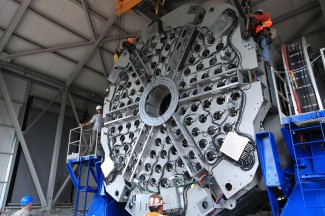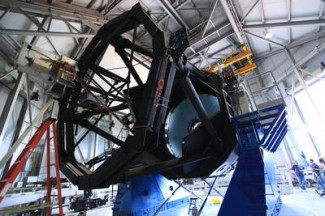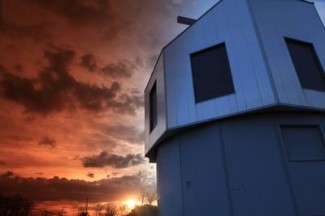INTERVIEW: Discovery Channel set to unveil landmark telescope

Discovery Channel may dedicate much of its programming to the adventurous lifestyles and unique habitats of planet Earth, but the network doesn’t stop with the outer limits of the atmosphere.
On Sunday, Sept. 9 at 7 p.m., the channel is set to premiere Scanning the Skies: The Discovery Channel Telescope, a documentary eight years in the making. The one-hour program serves as a kickoff event for a new landmark telescope based at the Lowell Observatory in Flagstaff, Ariz. The TV special is the first step in a larger project that will see many facets of Discovery Communications engaging with its audience and collectively focusing on some intense star-gazing.
Recently, Hollywood Soapbox talked with Brooke Runnette, executive producer of Scanning the Skies, about how the telescope project originated and how it might inspire a new generation of astronomers. Questions and answers have been slightly edited.
How long have you been with the project?
Well, I’ve been with the project for only a fraction of time, which is a couple of years. (laughs) It’s been going on for a long time. Because it’s not just a documentary. I mean you know that we really gave significant — and John Hendricks in particular — gave significant personal support to the building of this telescope. So basically the show is documenting something really real that is … one of the newest, sort of fantastic telescopes out there.

So the documentary is similar to a kickoff event?
The way that I think about it is almost like a storefront. It’s like, hey, look at this. Here is the kickoff, the introduction, but what we’re going to be doing, what (Discovery) Education is going to be doing, what our online people are going to be doing, will be going on for years. …
So what’s difficult about a telescope, any telescope, is purely time, time on the telescope. So that’s the bottleneck of all astronomy is getting time on the telescope. So what these guys have been able to do by building this is to not only have Lowell and his partners have time on this telescope, but also to make sure … that it really becomes something that kids out there, students and everything, will have a chance to really participate in, so far as you can without actually be up on the hill in Flagstaff, in having this amazing telescope that’s looking out into the sky. So, it’s a cool project.
Have the cameras been rolling since the beginning?
The idea all along was as soon as this thing really starts construction that the cameras would absolutely be there. So we have been. We filmed every single bit of it. And obviously there’s way more tape than we could ever get into a show. … But the other thing that was cool about it is that there was a celebration for it on July 20 in Flagstaff, at which the featured speaker was Neil Armstrong in his last public appearance. He gave this great and impassionate speech, and we’re going to put the top of it at the top of the show. … He thought this kind of stuff was really worth it. That you couldn’t just say, ‘But does it feed people? Does it help the economy?’ And all that kind of stuff. That looking into the universe and exploring space was worthy of all of our efforts.
Because NASA and astronomy as a whole has taken a hit recently, does that give your program more importance? If you win over some people on Sunday night, you might hook a generation to look up at the sky.
I can’t even tell you how much that is John Hendricks’ hope and dream for this. … There’s a tremendous need for help for people to not only give money to science when they can, but also so that we can all encourage a new generation of innovation, of people who look into space literally and who are dreaming of being scientists. That is really, I would say, not to speak for John (Hendricks), but that is what he really hopes with this.

What was the biggest challenge for you in your role?
A show that just builds something is always kind of a challenge. But this has some really cool bits to it. I mean the precision with which they have to put this thing together is just staggering. It’s absolutely staggering. They spent three years simply polishing one of the years. Three years. Imagine, wake up in the morning, go to work, polish, polish, polish. OK, that’s a day of work. (laughs) And they have to do that for three years just to get it exactly right. There’s some crazy thing like … if the surface of the mirror was the size of the United States, the amount by which it can err is about an inch, which is crazy. … The width of the human hair would wreck the entire thing. …
But then we also just want to make sure that people understand this overall project of telescopes in general is looking out into the universe to answer some of our most essential questions. And to make sure that people realize that this is a machine for plumbing the mysteries of the universe actually.
Are you very conscious of your target audience? Is it a family show?
I think it’s definitely for family co-viewing. It’s definitely to sit down with the family and sort of talk about these things, talk about (what) Neil Armstrong is asking at the beginning. We’ve definitely have this whole idea of what is this? What is this thing called astronomy that we try to do? Which is looking out into the universe and figuring out where do we come from. And then how does human ingenuity focus itself and create something so precise that it can look at unimaginable distances into the universe and figure out little bits of things. Like does this tiny little possible shadow that crosses a possible star, could it really be a planet? And could it have an atmosphere?
By John Soltes / Publisher / John@HollywoodSoapbox.com
-
Scanning the Skies: The Discovery Channel Telescope airs Sunday, Sept. 9 at 7 p.m. on Discovery Channel.


The day when “Scanning the Skies” aired I was in the middle of channel surfing when I stubble upon the reveal of the new telescope. I had no idea how much work and the different components went in to this project. Sadly, I wasn’t able to view the entire showing due to prior engagements, but I would diffidently watch it again. Two thumbs up!